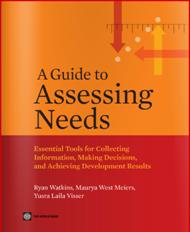My name is Maurya West Meiers and I work at the World Bank as an Evaluation Officer. I’m writing to share  information from our book on planning for and managing your needs assessment.
information from our book on planning for and managing your needs assessment.
Lessons Learned – Use checklists: Don’t underestimate the power and usefulness of checklists. Airline pilots are required to use them. Many surgeons do, too. They help us to break down larger tasks into component parts – to avoid problems and to achieve better results in our work. So when you are planning your next needs assessment, I have a checklist for you to adapt and use. The provided checklist is intended for a larger scale needs assessment, but you should alter your checklist depending on the scale of your assessment. This checklist and other needs assessment management tools are found (in Appendix A) in the recently published World Bank book, A Guide to Assessing Needs: Essential Tools for Collecting Information, Making Decisions, and Achieving Development Results, written by Ryan Watkins, Yusra Laila Visser and me. The book is available through free download.
Lessons Learned – You’re not limited to surveys, interviews and focus groups: While surveys and focus groups are wonderful tools, there are so many more tools and techniques that you can use for both data collection and decision-making purposes. Have you ever used nominal group technique? How about fishbone diagrams, World Café or multicriteria analysis? Our book has summaries of 23 tools and techniques such as these.
Lessons Learned – Consult a range of stakeholders in developing your needs assessment plans: It should go without saying that if you want the results of your assessment will be more accepted if you have given stakeholders and opportunity to review and comment on the plans. This may involve multiple meetings and interviews but will be worth the extra effort.
Lessons Learned – Your management plan should be a living document: Odds are high that your needs assessment plans will change as more information becomes available. Update your plans and checklists. Be sure to share them not only with your team carrying out the plans, but also with other stakeholders (e.g., community members, the agency requesting the needs assessment, and so on).
Rad Resources
- Many needs assessment resources can be found at gapsinresults.com .
- Though not well known, dual response surveys are valuable tools for needs assessments.
- If you are not convinced about the utility of checklists, check out the terrific book, The Checklist Manifesto, by Atul Gawande.
The American Evaluation Association is celebrating Needs Assessment (NA) Week with our colleagues in the NA AEA Topical Interest Group. The contributions all this week to aea365 come from our NA TIG colleagues. Do you have questions, concerns, kudos, or content to extend this aea365 contribution? Please add them in the comments section for this post on theaea365 webpageso that we may enrich our community of practice. Would you like to submit an aea365 Tip? Please send a note of interest to aea365@eval.org. aea365 is sponsored by the American Evaluation Association and provides a Tip-a-Day by and for evaluators.
